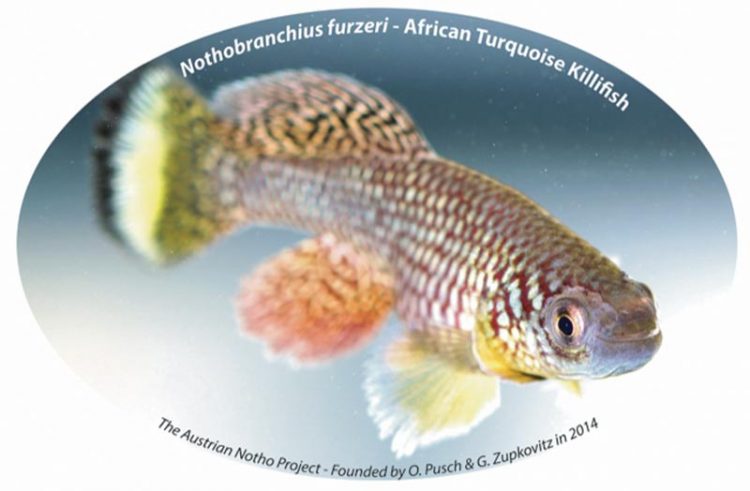Important aging mechanism in fish model Nothobranchius furzeri revealed

An important aging mechanism, a permanent reduction of histone deacetylases, was recently identified in the african Killifish, N. furzeri. The Austrian Northo Project
People have long been dealing with questions about the mechanisms that make our body cells age and how to counteract these mechanisms. Due to their function in cell cycle regulation, histone deacetylases, HDACs, are considered to play an essential role in the cellular aging process and in the development of neurodegenerative diseases.
A research team around Sabine Lagger from the Unit of Pathology of Laboratory Animals of the University of Veterinary Medicine Vienna, in collaboration with Gordin Zupkovitz and Oliver Pusch from the Medical University of Vienna analysed these connections and confirmed a clear mechanism in the extremely short-lived killifish from the onset of embryogenesis until the last phase of life.
Cell cycle inhibitor replaces positive regulation enzymes in the aging process
The short-lived turquoise killifish, Nothobranchius furzeri, has been an emerging model organism in aging research for several years. Since 2014, the Medical University of Vienna has been conducting research into this species in its Killifish Facility, which constitutes the only one of its kind in Austria.
The species’ short lifespan of about four months is not the only argument, as N. furzeri also shows clear signs of aging such as dementia and cancerous lesions. Additionally a fully annotated genome is available. This “comprehensive package” enables analyses of cellular aging processes, virtually in fast forward motion.
“We analysed the expression of histone deacetylases because these proteins are often related to aging processes,” explained Lagger. HDACs are involved in mechanisms how the genome is transcribed in a particular moment. The DNA does not exist freely in cells but is wrapped around complex protein structures. It is, in a way, strategically packed.
“Some parts can be modified by certain chemical modifications so that specific genes can be transcribed or not. Which parts are accessible or not depends on external factors, such as environmental conditions, stress, or endogenous processes, such as aging,” said the lead author.
The analyses done by the team showed that the expression levels of HDACs was constantly downregulated in aging killifish. This decrease of available HDACs resulted in the increasing production of the cell cycle inhibitor protein p21. The researchers also confirmed this dynamic in a mammalian animal model. “The HDAC-p21 connection was mirrored in the mouse. This even allows us to conclude that there is an evolutionarily conserved mechanism of cellular aging,” said Lagger.
Epigenetic background could open doors for an active compound strategy
Furthermore, the availability of HDACs and the connection with the aging process is interesting because it influences the epigenetic regulation of the cell cycle. “In contrast to genetic mutations in the DNA sequence, epigenetic changes are reversible. This could be an approach for the development of active compounds able to inhibit the described mechanism,” concludes Lagger.
About the University of Veterinary Medicine, Vienna
The University of Veterinary Medicine, Vienna in Austria is one of the leading academic and research institutions in the field of Veterinary Sciences in Europe. About 1,300 employees and 2,300 students work on the campus in the north of Vienna which also houses five university clinics and various research sites. Outside of Vienna the university operates Teaching and Research Farms. The Vetmeduni Vienna plays in the global top league: in 2018, it occupies the excellent place 6 in the world-wide Shanghai University veterinary in the subject “Veterinary Science”. http://www.vetmeduni.ac.at
Released by:
Georg Mair
Science Communication / Corporate Communications
University of Veterinary Medicine Vienna (Vetmeduni Vienna)
T +43 1 25077-1165
georg.mair@vetmeduni.ac.at
Sabine Lagger
Unit of Pathology of Laboratory Animals
University of Veterinary Medicine Vienna (Vetmeduni Vienna)
T +43 1 25077-2423
sabine.lagger@vetmeduni.ac.at
The article “Histone deacetylase 1 expression is inversely correlated with age in the short-lived fish Nothobranchius furzeri“ by Gordin Zupkovitz, Sabine Lagger, David Martin, Marianne Steiner, Astrid Hagelkruys, Christian Seiser, Christian Schöfer and Oliver Pusch was published in Histochemistry and Cell Biology.
https://link.springer.com/article/10.1007%2Fs00418-018-1687-4
https://www.vetmeduni.ac.at/en/infoservice/presseinformation/presse-releases-201…
Media Contact
All latest news from the category: Life Sciences and Chemistry
Articles and reports from the Life Sciences and chemistry area deal with applied and basic research into modern biology, chemistry and human medicine.
Valuable information can be found on a range of life sciences fields including bacteriology, biochemistry, bionics, bioinformatics, biophysics, biotechnology, genetics, geobotany, human biology, marine biology, microbiology, molecular biology, cellular biology, zoology, bioinorganic chemistry, microchemistry and environmental chemistry.
Newest articles
Faster, more energy-efficient way to manufacture an industrially important chemical
Zirconium combined with silicon nitride enhances the conversion of propane — present in natural gas — needed to create in-demand plastic, polypropylene. Polypropylene is a common type of plastic found…

Energy planning in Ghana as a role model for the world
Improving the resilience of energy systems in the Global South. What criteria should we use to better plan for resilient energy systems? How do socio-economic, technical and climate change related…

Artificial blood vessels could improve heart bypass outcomes
Artificial blood vessels could improve heart bypass outcomes. 3D-printed blood vessels, which closely mimic the properties of human veins, could transform the treatment of cardiovascular diseases. Strong, flexible, gel-like tubes…




















